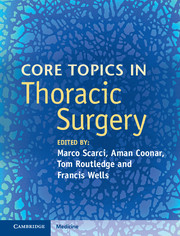Book contents
- Frontmatter
- Contents
- List of contributors
- Section I Diagnostic work-up of the thoracic surgery patient
- Section II Upper airway
- Section III Benign conditions of the lung
- Section IV Malignant conditions of the lung
- Section V Diseases of the pleura
- Section VI Diseases of the chest wall and diaphragm
- Section VII Disorders of the esophagus
- Section VIII Other topics
- 26 Thoracic trauma
- 27 Thoracic sympathectomy in the treatment of hyperhidrosis
- Index
- References
26 - Thoracic trauma
from Section VIII - Other topics
Published online by Cambridge University Press: 05 September 2016
- Frontmatter
- Contents
- List of contributors
- Section I Diagnostic work-up of the thoracic surgery patient
- Section II Upper airway
- Section III Benign conditions of the lung
- Section IV Malignant conditions of the lung
- Section V Diseases of the pleura
- Section VI Diseases of the chest wall and diaphragm
- Section VII Disorders of the esophagus
- Section VIII Other topics
- 26 Thoracic trauma
- 27 Thoracic sympathectomy in the treatment of hyperhidrosis
- Index
- References
Summary
Introduction
Thoracic trauma, whether blunt or penetrating, is the leading cause of death in trauma victims in Europe and North America after injuries to the head and spinal cord. The proportion of penetrating trauma varies geographically. In Europe, the incidence of penetrating trauma is generally lower (about 10%) than in the United States (about 20%). While blunt trauma frequently leads to respiratory compromise with hypoxia, hypercarbia and acidosis, penetrating forces often result in a certain degree of blood loss and occasionally in life-threatening, exsanguinating injuries to the heart and great vessels. The majority of traumatic chest injuries can be managed by airway control and placement of a chest tube.
After elucidating some general aspects of blunt and penetrating injuries to the chest, the diagnosis and management of specific injuries are discussed.
Blunt chest trauma
Blunt injury to the thorax directly accounts for approximately 25% of trauma-related mortality and is a major contributor in another more than 25% of deaths, as it is often associated with trauma to the abdomen and particularly the head. In-hospital mortality rates for isolated blunt chest injuries are in the range of 1–2%. The most important causes of blunt chest trauma in Europe and Northern America include traffic accidents, followed by violence. Fortunately, approximately 90% of blunt chest injuries can be managed non-operatively by appropriate analgesia, tube thoracostomy and aggressive respiratory therapy, eventually including endotracheal intubation and mechanical ventilation. Emergency thoracotomy is rarely required (in about 2%) in blunt thoracic trauma victims and is generally only indicated in patients suffering from cardiac arrest due to pericardial tamponade and in situations of a witnessed cardiac arrest in the emergency department.
Important details, which should be obtained in the patient's clinical history in order to raise suspicion of specific injuries, are the mechanism (fall/car crash, height/velocity) and time of injury as well as cardiopulmonary co-morbidities. As direct impacts over the thorax may lead to rib fractures (including flail chest), pulmonary and cardiac contusions, high-velocity impacts with simultaneous presence of a closed glottis may even cause bronchial disruption. In addition, impacts on the abdomen lead to associated injuries of abdominal organs and may cause diaphragmatic rupture due to a sudden rise in intra-abdominal pressure. Rapid deceleration (fall from height, car crash) can lead to aortic rupture as well as tracheobronchial injuries as a result of antero-posterior compression of the chest.
- Type
- Chapter
- Information
- Core Topics in Thoracic Surgery , pp. 253 - 266Publisher: Cambridge University PressPrint publication year: 2016

